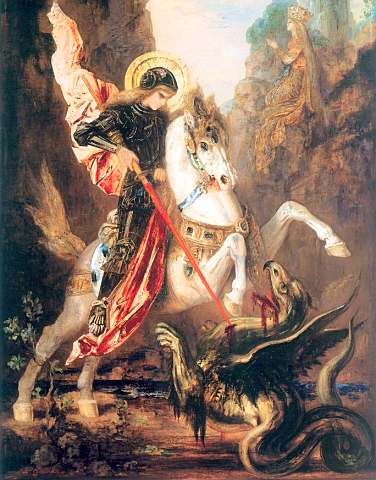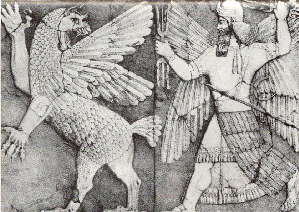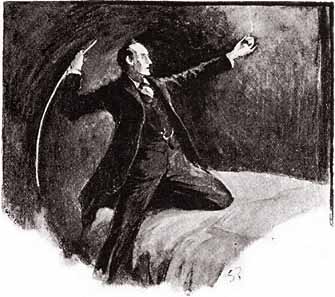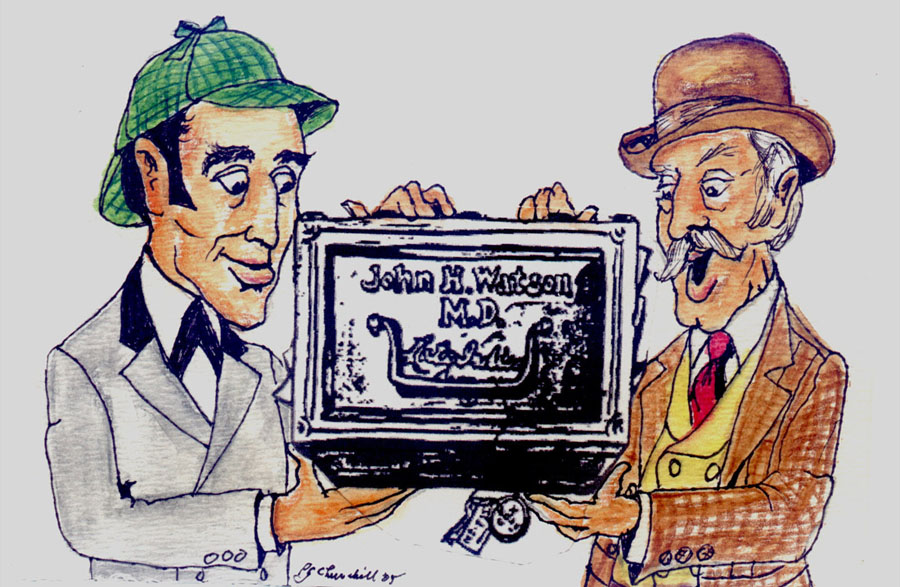A sample article from the third issue
of Irene's Cabinet published by

of Ellicott City, Maryland
The Serpent and the Sorcerer-Knight
By John C. Sherwood
"It is a romance!" cried Mrs. Forrester. "An injured
lady, half a million in treasure, a black cannibal, and a
wooden-legged ruffian. They take the place of the
conventional dragon or wicked earl."
"And two knight-errants to the rescue," added Miss Morstan.
… "
– From The Sign of Four, published 1890
We take many of our favorite Canonical images for granted.
They were, after all, “created by Sir Arthur Conan Doyle.”
But when these complex images are lightly scratched, they
reveal underlying aspects of something unintended,
unconscious, ancient and archetypal.
On close examination, they may even include spiritual
allegories, rooted in earlier centuries – and, ironically,
in the religious faith Conan Doyle had consciously
dismissed.
Conan Doyle was born into a family that practiced Roman
Catholicism in a culture where Anglicans and Presbyterians
dominated. In time, however, his mind left no room for any
religion he saw as inflexible and unprovable. He made his
formal break with traditional faith while in his 20s.
By then, however, the Church’s values and iconography were
etched on his mind even though he consciously rejected
their theological meaning. As a result, the symbols of
traditional faith were to emerge in his writings – symbols
that may not have been entirely intended, but which
produced forms that had lasting subliminal impact on
readers.

|
The illustration at left shows St. George using his lance to slay a dragon in its cavern.
In fact, almost from the start of the Holmes saga, Conan
Doyle borrowed from images inspired by religious faith –
specifically, the iconography of Roman Catholic belief,
history and symbolism:
Conan Doyle couldn’t have avoided seeing these icons. Among
the ruins of England’s abbeys and churches linger thousands
of figures that for centuries spoke to the masses. These
figures embody the battle between good and evil, typically
in the form of a knight – a soldier of God – slaying a
dragon or serpent, rescuing the world’s future –
represented by a maiden – from Satan, in the form of a
corrupted sorcerer.
Such images probably weren’t in Conan Doyle’s conscious
mind when, at age 28, he set pen to paper to produce
A Study in Scarlet.. As is known, his
purpose was – in addition to paying his bills – to create a
thoroughly modern detective cast in a scientific mold.
Still, religious faith – represented by Mormonism – had
much to do with the tale. In fact, the resulting novel was
slyly critical of intense religious faith, representing
Conan Doyle’s sweeping, youthful view of spiritual
subjects. To underscore the point, he provided a hero with
no relationship to faith whatsoever.
The scientifically minded Sherlock Holmes became a
figurehead of reason and law in contrast to a form of
faith-based life depicted – shallowly – as of doubtful
merit. In this first novel, Conan Doyle had a young,
jocular and sociable Holmes write an article, “The Book of
Life,” which – instead of stating a philosophy involving
spirituality – sets forth a philosophy of pure reason.
Thus, in an interpretive sense, A Study in
Scarlet became the young Conan Doyle’s statement
that reason could triumph in the face of actions motivated
by irrational emotions and belief.
Faith and its forms would hold Conan Doyle's mind in a firm
grip all his writing life, and he would produce many works
that dealt with the nature of belief in a variety of forms
– most notably his own late-in-life trust in Spiritualism.
When Conan Doyle was 30, Lippincott's Magazine asked him to
produce a new Holmes novel. He retained his notion of a
scientific detective, but felt he should embellish the
product. He re-invented Holmes as a reclusive drug addict
who rises above his personal drawbacks to battle sinister
forces. Superficially stated, Holmes finds a task to
occupy his powers – and to avoid the need for stimulating
drugs.
However, beneath this image's veneer is something very old.
It’s the persona of the shaman – the healer, seer and
seeker of knowledge who turns to mental stimulants as part
of his regimen – recast as a modern sorcerer of detection.
Just as the shaman fights evil spirits on behalf of his
tribe, Holmes now sets forth against the forces of greed
and death, which in The Sign of Four appear
as a modernized dragon (Tonga, who used his breath to kill)
and “wicked earls” (Small, Col. Morstan and Sholto).
The images of knights and dragons are pervasive in
literature and myth, and were compelling to a man such as
Conan Doyle, who considered his greatest fiction to be his
tales that harkened back to an age of chivalry.
In this second Holmes novel, the detective emerges – much
more fully formed – as just such a chivalrous being. He
achieves the state of emblematic goodness stated outright
by Mary Morstan, as a bachelor knight-errant serving a
noble cause. Watson, in his most primal yet exalted moment
in the Canon, even wins the supreme prize – the hand of the
tale’s beleaguered maiden. The Duo thus entered the
pantheon of a grand tradition.
Fifteen years after first painting Holmes so nobly, Conan
Doyle returned to a similar image, this time stated by
Watson himself in reference to Charles Augustus Milverton:
“I understood the joy which it gave [Holmes] to be
confronted with this green and gold monster, the dragon
which held in its maw the reputations of many fair ladies.”
Conan Doyle painted Holmes’s enemies and dark sojourns with
evocative images and names. Yes, he may have chosen the
names “Moriarty” and “Moran” because they hint at a link
with the “Irish mafia”; but the first syllable – the Greek
root mor – has a long and splendid mythic
history, associated in our language with sleep, death and
murder.
In Europe’s most ancient tales, the enemies of King
Arthur’s knights were Morgana and Mordred. J.R.R. Tolkien,
an expert of ancient literature, used similar names
blatantly in his fiction: His Sauron is corrupted by the
supreme dark lord Morgoth; Sauron’s tower lies in Mordor;
the Balrog falls into the chasm in Moria.
Conan Doyle did much the same. The blue carbuncle that
spawns greed and death belongs to the Countess of Morcar.
And the greedy Grimsby Roylott’s estate is Stoke Moran. Add
a few letters to Tolkien’s chasm-ridden “Moria” and you get
“Moriarty,” who also plunged into a great chasm.
Holmes’s deeds in “The Speckled Band” parallel the trials
of the perfect knight in medieval legend. In myth, the
knight and his squire typically circumvent bizarre
creatures – usually including a large cat such as a lion –
before entering the dark cave to confront the dragon.
Holmes and his squire, Watson, do the same, a leopard
serving as their huge feline. In the dark chamber itself,
Holmes lies in wait and eventually drives the deadly
serpent back against its master, who dies. Evil is
thwarted, and the intended victim is restored to her
legacy, to marriage and the fertility of the world.
Of course there are no Indian swamp adders that climb ropes
or respond to a flute. Whether the story is possible or
believable isn’t relevant. The supernatural serpent is
stopped. The maiden is rescued. The evildoer is obliterated. Thus order is restored, and justice is served.
Conan Doyle has Holmes state this reassurance at the end of
“The Speckled Band”: “Violence does, in truth, recoil upon
the violent, and the schemer falls into the pit which he
digs for another.”
Such words were part of Conan Doyle’s religious and secular
education: “He that diggeth a pit shall fall into it"
(Ecclesiastes 10:8). “Whoso diggeth a pit shall fall
therein” (Proverbs 26:27). John Milton’s Paradise
Lost described Satan’s fall into the pit. A
little more than a year after “Band” first saw print, the
Reichenbach demanded the same word – a “boiling pit of
incalculable depth.” Thus Holmes’s role as a soldier of
God did not change much during the 15 months that separated
publication of “The Speckled Band” and “The Final Problem.”

|
At right: Using thunderbolts, the sun god drives back the reptilian
chaos monster in a 9th century B.C. panel from the palace
of Assyria.
For Conan Doyle, that image worked powerfully – and stayed
with him. By 1927, both “Band” and “Problem” ranked among
the author’s top four favorite Holmes stories, with “Band”
his favorite. Both stories – with The Hound of the
Baskervilles – still rank among the most popular.
Despite that impossible snake, “The Speckled Band” actually
leads those polls.
When we ask “Why?” we point to Conan Doyle’s plotting – but
what he plotted so well was at root a spiritual allegory.
Joseph Campbell's The Hero with a Thousand Faces shows a 9th century B.C. alabaster panel from the palace of an Assyrian king. It shows the Assyrian sun god, holding lance-like thunderbolts, driving away a flying dragon.
Most people then – as now – had never seen a sun god, let
alone a flying dragon. But that did not stop the carver
from producing this image. He did not fear those who might
say, “There is no such creature.” Neither did Conan Doyle.

|
At left: Using his cane, Holmes drives back the swamp adder in the
famous illustration by Sidney Paget for "The Speckled
Band."
As far as conveying the action, that 3,000-year-old panel
is identical with Sidney Paget’s illustration of Holmes
lashing at the equally nonexistent swamp adder. And it is
the same allegory – powerful evil fleeing from powerful
good.
In the same fashion, the Dartmoor of The Hound is a fantasy land. The real Dartmoor never could
support a stately manor; it never harbored gypsies or
fatally deep mires. It was necessary for Conan Doyle to
transform the region into a land of myth, where a dog –
bred into a canine dragon – could be immune to phosphorous
so fire might “burst from its open mouth.”
In this land of sudden fogs and roaming horrors, Holmes
slays the impossible beast. The schemer Stapleton
presumably plunges into the mire, where fiends belong. The
ensnared Beryl is freed and the realm made safe under the
returned baronet.
This is myth, replete with all the flavors
of the ancient recipe. The tasty proof is in the pudding:
When most people read “The Speckled Band” or The
Hound, they are satisfied.
Impossibilities be damned – skepticism is set aside by even
the most reasonable, ignored for a simple reason: These
tales reach that part of the psyche that craves justice,
reassurance and the restoration of an orderly universe.
So it’s no wonder the tales mentioned here, by and large,
remain the most popular among the reading public. Through
them, a touch of the Unknown enters our souls, transforming
Holmes into something more than a mere man. Subliminally,
we recognize that most mysterious of beings, a chivalrous
wizard who – though plagued by drug-induced visions – can
see the future, heal the afflicted and chase away the dread
demons that torment the innocent.
At root, then, the Canon fascinates us not because it
offers a plea for reason in an irrational world, but
because it allows us to believe in the divinity of
reason. It's an irrational notion itself, a form
of faith in its own right. And Conan Doyle wins the credit
for having shaped it for the modern age.
REFERENCES
Austin, Bliss. 1989. “A Sherlock Holmes Competition,” in
The Baker Street Dozen, edited by Pj Doyle and E.W.
McDiarmid (New York, N.Y.: Congdon & Weed Inc.)
Campbell, Joseph. 1949. The Hero With a Thousand Faces
(Princeton, N.J.: Princeton University Press).
Clark, Debbie. March 1968. “Holmes – A Wizard?” Baker
Street Pages, No. 33, p. 1.
Clarkson, Steve. 1999. The Canonical Compendium. (Ashcroft,
British Columbia, Canada: Calabash Press).
Conan Doyle, Sir Arthur. 1887-1927. Various tales about
Sherlock Holmes. For textural quotes, this essay relied on
the CD-ROM publication Sherlock Holmes on Disc, 1989-92,
distributed by Multimedia Corporation.
Stashower, Daniel. 1999. Teller of Tales: The Life of Arthur Conan Doyle (New York: Henry Holt and Company)
Stock, Randall. December 1999. “Rating the Canon,” Baker
Street Journal, Vol. 49, No. 4, New Series (Indianapolis, Ind.: Baker Street Irregulars).
• Click image below to visit WatsonsTinBox.org. •









